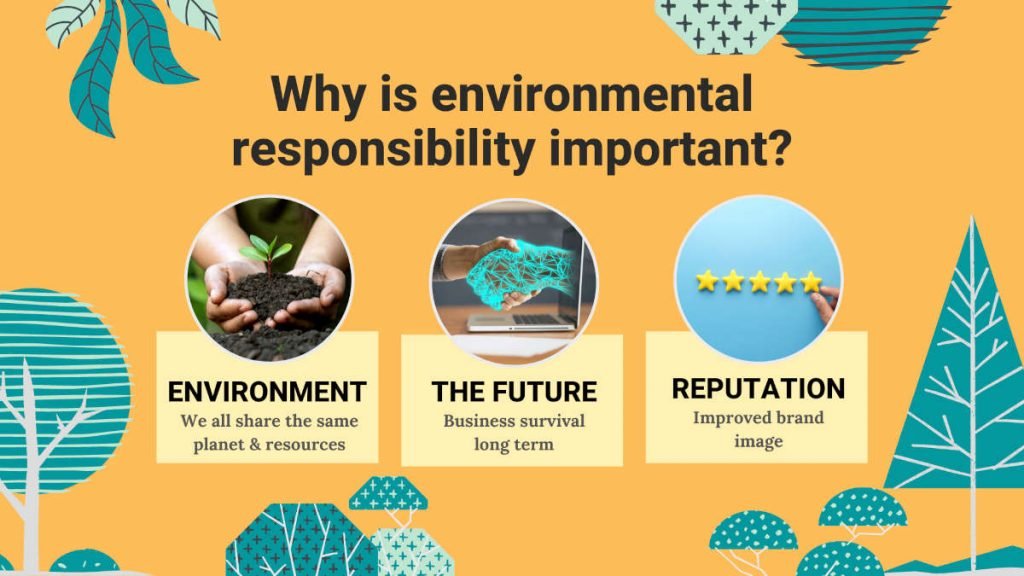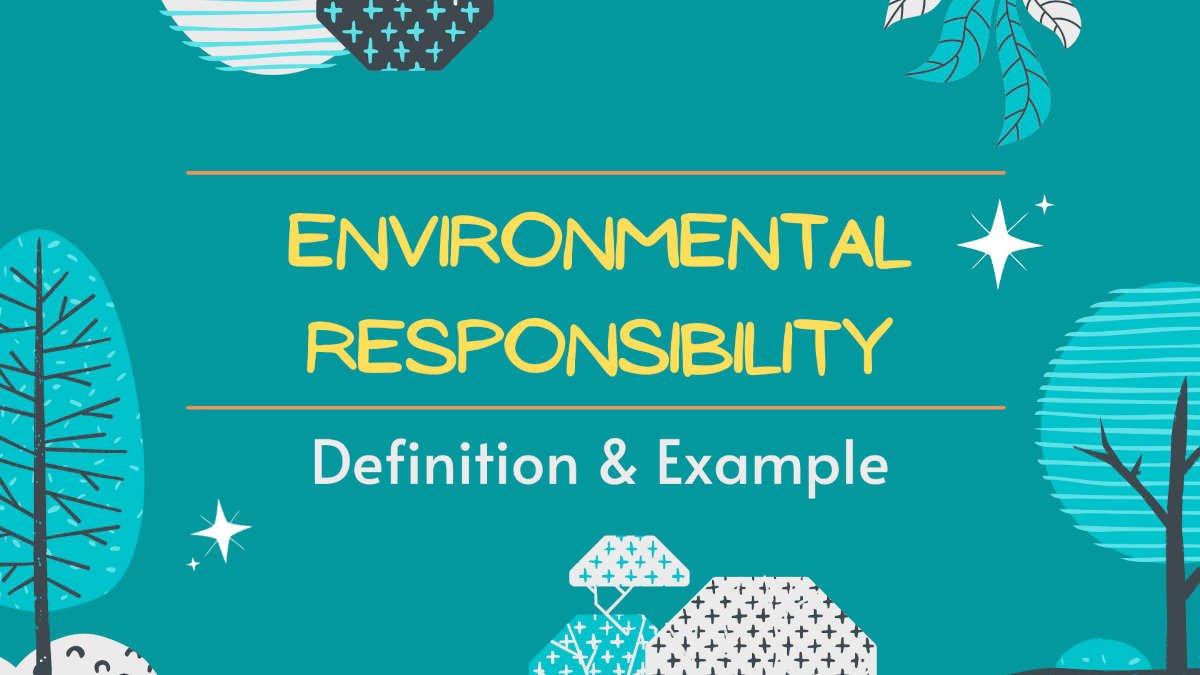Nowadays environmental responsibility examples are all around us, as corporations scramble to announce their new environmental sustainability efforts.
Environmental responsibility is the duty of businesses to prevent and alleviate the environmental damage that may be caused by their commercial activities. A growing number of institutional investors evaluate the company’s environmental responsibility efforts before eventually investing.
At the same time, governments are also imposing strict environmental standards and regulations.
Key Takeaways
- Companies can make a significant environmental impact through responsible supply chain choices.
- Reducing resource use and waste benefits both the environment and business efficiency.
- Investing in green technologies and digital transformation enhances sustainability and profitability.
Before going more into detail regarding the reasons for becoming an environmentally responsible business and the actions that companies could take, let’s better explain the concept with a great example!
environmental responsibility Example: Ikea
Most large companies still have a long way to go with increasing their green practices until they can truly be called examples of environmental responsibility. There are also inherent difficulties with becoming sustainable when your business model is centred on more disposable and mass-produced products.
The Swedish furniture retailer IKEA is an interesting example of environmental responsibility. IKEA is a company that has devoted much more effort than most to making environmental conservation one of its primary goals.

Almost all of the wood used in IKEA products comes from sustainable sources, including recycled wood.
Their furniture is also designed so that waste is minimised during production, and is made to be lighter so that less fuel is used during transport.
100% of IKEA’s cotton also comes from sustainable sources, and it aims to do the same with wool within the next few years.
The company has similar goals when it comes to plastic, though there is still a way to go yet, as it currently aims to use only recycled and renewable plastics by 2030. It has now phased out single-use disposable plastic products, including plastic shopping bags, and has replaced them with disposables from renewable sources.
IKEA has also successfully become energy independent, relying completely on renewable energy that is generated by itself, such as by the countless solar panels that cover its stores, as well as by owning hundreds of wind turbines.
The company certainly still has many problems with environmental sustainability, including the inherent problems with its business model, such as how they encourage customers to buy more than they need, and how it is often easier to just buy new IKEA products than to repair older or damaged pieces of furniture.
Despite these issues, the company is still continuing to move in the right direction, and it will be enlightening to see how they tackle those problems in the future.
IKEA is without a doubt an interesting example of how companies can try to apply environmentally conscious practices to become more sustainable.
Suggested read:
Why is environmental responsibility important?
Responsible environmental efforts are important because every person who has ever lived has depended on the natural world for their survival, and that has not changed for people living in the modern world.

Our needs, however, have far exceeded what our environment can provide to us, and as a result, we are now living in a critical time period where it is imperative that we transition to sustainable ways of living.
All businesses worldwide play a central part in creating that better future. To do so, companies should adopt a triple bottom line sustainability model: environmental protection, social equity, and economic profit. Where environmental responsibility is key to achieving the goals of the ecological preservation and long term success of the business.
In the modern world, companies contribute extensively to environmental degradation, and every company that continues to damage the environment is contributing to creating a less hospitable world for future generations to live in.
Knowing this, it is clear that all businesses, both big and small, have a responsibility to take action to reduce their negative impact on the world and give back to it in any way that they can.
Beyond just preventing damage to the environment and the devastating consequences that will arise from that, there are many reasons why a business should make environmental responsibility one of its highest priorities.
To start with, being an environmentally friendly company means reducing waste and using less energy and other resources, which leads to increased efficiency and lower costs as a very tangible advantage over companies that do not do the same. Here are a couple more reasons to keep in mind:
Preparing For The Future
Environmental responsibility will soon be essential for ensuring that a business can survive over the long term.
Many common and profitable, but very damaging, business practices will become less and less viable in the coming years, as more people begin to place more importance on buying products from responsible companies, and as tighter restrictions are placed on how various products can be manufactured.
For one example, in July 2021 the European Union introduced a ban on many single-use plastic products, such as straws and cutlery, as well as some products made of other materials such as polystyrene, in order to reduce marine waste. This means that, at some point, plastic-free products, like shampoos, conditioners, and much more, would be the only ones available.
More restrictions on plastic products in the EU are also planned, and once alternatives to them arrive it is certain that other environmentally damaging materials will have restrictions placed on them.
It is likely many other countries will introduce similar restrictions in the future, affecting companies in many places around the world.
Businesses that rely heavily on environmentally irresponsible practices will have a harder time transitioning when laws such as these come into effect and will face legal issues if they fail to do so in time.
Reputation
Environmental responsibility is not just a legal thing, but an ethical one too, and people all around the world are becoming increasingly aware of just how important it is.
It is not enough for businesses to just do the bare minimum of obeying laws relating to environmental sustainability. In order to make a real difference, they have to do more and will be expected to do more.
Purchasing products and services that do not harm the environment is becoming an increasingly high priority for many people, especially younger generations, even if it means having to pay more. As a result, businesses which fail to meet these higher standards of environmental friendliness will inevitably look less attractive and lose customers.
A company may have much to lose if it fails to meet expectations for protecting the environment, but on the other hand, businesses that take the initiative and make environmental responsibility a priority will have much to gain, as more and more potential customers are beginning to search for environmentally friendly businesses to buy from.
A sustainable and responsible business will also have the advantage of attracting skilled and experienced potential employees who would have avoided working at an irresponsible company.
Actions to take for environmental responsibility

It is not always easy to transition to more sustainable ways of operating a business, as for all companies in the world to operate effectively with no environmental impact whatsoever, changes on a much larger, worldwide scale are needed.
Despite this, most companies still have a lot of control over their impact on the natural environment, and certainly, enough to make a meaningful difference.
Here are examples of a few changes that can make a big difference:
- Consider who you purchase your supplies, power and other resources from. Are you already purchasing supplies from sustainable and responsible sources, or could you search for better ones? Are your products being made from responsibly-sourced materials? You could also see if you could make your power use more environmentally friendly, such as by installing solar panels on the roofs of the company’s buildings or applying any of the existing examples of sustainability to your business. Solar energy offers interesting benefits to the environment, so it is often high on the list for many business leaders.
- Try to reduce the resources that your business uses, which will reduce costs as well. For example, you could ensure that your workplaces do not use more power than they need to, by purchasing more efficient lighting, heating and other electronics, and encouraging employees to save power wherever possible. You should also reduce waste from supplies you use, such as paper and stationery if the workplace is an office or recycle cardboard for businesses such as supermarkets.
- Invest in new digital technologies to improve your products, manufacturing processes and much more. Being more efficient and having a better product design can not only reduce the energy and raw materials consumption but can also attract new customers and increase the business profitability while also improving sustainability thanks to green technologies.
- Take a look at what impact some of your daily business activities have. For example, if you and your employees often need to travel, try to see if there are more sustainable options for doing so, especially if you often travel by air. Ideally, you could eliminate the need to travel completely by holding meetings and other activities remotely.
- Ensure that you recycle and reuse everything that you can. You should also purchase things such as office supplies that are made of recycled material.
- If you need to build new facilities, keep sustainable urban design in mind and make sure to use sustainable construction materials and renewable sources. Making sure that the new construction is built to last will also help in reducing its long term environmental impact.
- Plant trees. The world needs a lot more trees in it, and every company can help repair the damage we’ve done, for example by planting more trees on its own premises or donating a percentage of its sales to organisations that plant more trees all around the world.
Conclusion
The damage that unsustainable practices, such as open pit mining have had on the environment is immense and continues every day, but the tide is quickly beginning to turn and there are many reasons to be optimistic for the future.
When a business takes action to make its operations responsible and sustainable, it may seem like it is only making a small difference, but every company that does the same thing raises the bar slightly and helps to make environmental responsibility a standard that every business has to reach.


